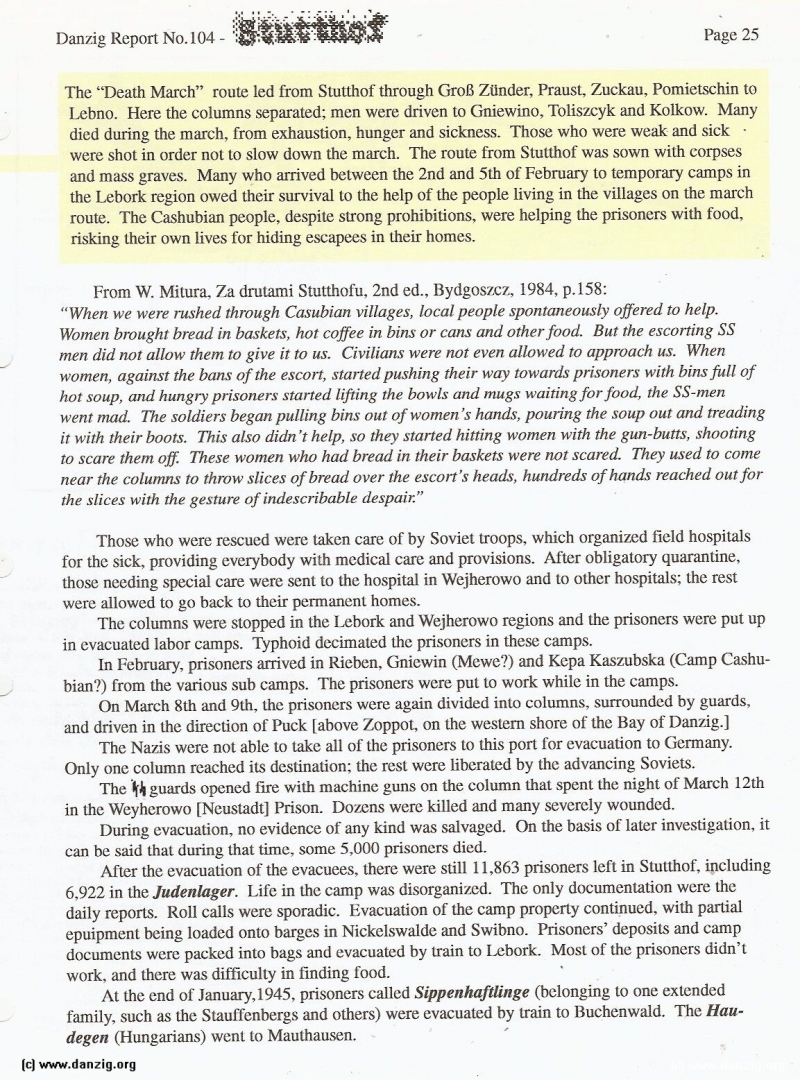
The “Death March” route led from Stutthof through GroB ZUnder, Praust, Zuckau, Pomietschin to Lebno. Here the columns separated; men were driven to Gniewino, Toliszcyk and Kolkow. Many died during the march, from exhaustion, hunger and sickness. Those who were weak and sick were shot in order not to slow down the march. The route from Stutthof was sown with corpses and mass graves. Many who arrived between the 2nd and 5th of February to temporary camps in the Lebork region owed their survival to the help of the people living in the villages on the march route. The Cashubian people, despite strong prohibitions, were helping the prisoners with food, risking their own lives for hiding escapees in their homes.
From W. Mitura, Za drutami Stutthofu, 2nd ed., Bydgoszcz, 1984, p.158: “When we were rushed through Casubian villages, local people spontaneously offered to help. Women brought bread in baskets, hot coffee in bins or cans and other food. But the escorting SS men did not allow them to give it to us. Civilians were not even allowed to approach us. When women, against the bans of the escort, started pushing their way towards prisoners with bins full of hot soup, and hungry prisoners started lifting the bowls and mugs waiting for food, the SS-men went mad. The soldiers began pulling bins out of women’s hands, pouring the soup out and treading it with their boots. This also didn’t help, so they started hitting women with the gun-butts, shooting to scare them off These women who had bread in their baskets were not scared. They used to come near the columns to throw slices of bread over the escort’s heads, hundreds of hands reached out for the slices with the gesture of indescribable despair.”
Those who were rescued were taken care of by Soviet troops, which organized field hospitals for the sick, providing everybody with medical care and provisions. After obligatory quarantine. those needing special care were sent to the hospital in Wejherowo and to other hospitals; the rest were allowed to go hack to their permanent homes.
The columns were stopped in the Lehork and Wejherowo regions and the prisoners were put up in evacuated labor camps. Typhoid decimated the prisoners in these camps.
In February, prisoners arrived in Rieben, Gniewm (Mewe?) and Kepa Kaszubska (Camp Cashub ian?) from the various sub camps. The prisoners were put to work while in the camps.
On March 8th and 9th, the prisoners were again divided into columns, surrounded by guards. and driven in the direction of Puck [above Zoppot, on the western shore of the Bay of Danzig.]
The Nazis were not able to take all of the prisoners to this port for evacuation to Germany. Only one column reached its destination: the rest were liberated by the advancing Soviets.
The I guards opened fire with machine guns on the column that spent the night of March 12th in the Weyherowo [Ncustadtj Prison. Dozens were killed and many severely wounded.
During evacuation, no evidence of any kind was salvaged. On the basis of later investigation, it can be said that during that time, some 5,000 prisoners died.
After the evacuation of the evacuees, there were still 11,863 prisoners left in Stutthof, including 6,922 in the Judenlager. Life in the camp was disorganized. The only documentation were the daily reports. Roll calls were sporadic. Evacuation of the camp property continued, with partial epuipment being loaded onto barges in Nickclswalde and Swibno. Prisoners’ deposits and camp documents were packed into bags and evacuated by train to Lebork. Most of the prisoners didn’t work, and there was difficulty in linding food.
At the end of January,1945, prisoners called Sippenhaftlinge (belonging to one extended family, such as the Stauffenbergs and others) were evacuated by train to Buchenwald. The Haud egen (Hungarians) went to Mauthausen.
Danzig Report Vol. 1 - Nr. 104 - July - August - September - 1999, Page 26.
Hits: 3422
Added: 25/07/2015
Copyright: 2024 Danzig.org

